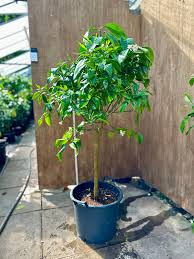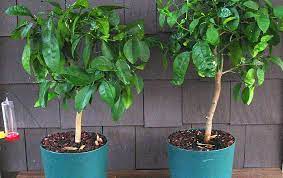Grapefruit trunk refers to the main stem or central woody axis of the grapefruit tree (Citrus × paradisi). The grapefruit (Citrus × paradisi) is a subtropical citrus tree known for its large, round, and yellow to pinkish fruit.
The trunk is the main stem of the grapefruit tree that supports the branches, leaves, flowers, and fruit. It is typically a thick, woody structure with bark covering its surface. The bark of the grapefruit trunk is the protective outer layer, consisting of several layers of tissue. It protects the inner, more delicate layers of the trunk from damage, pathogens, and moisture loss.
This is a thin layer of actively dividing cells just beneath the bark, responsible for growth in diameter of the trunk and branches. It generates new phloem (carries nutrients from leaves to other parts of the plant) and xylem (carries water and minerals from roots to other parts of the plant). These are the vascular tissues within the trunk that make up the bulk of the plant’s transport system. Xylem vessels transport water and minerals from the roots upward to the leaves and other parts of the plant, while phloem vessels transport sugars and nutrients produced during photosynthesis in the leaves to various parts of the plant.
The central, older, non-living part of the trunk, often darker in color. It provides structural support to the tree. The base of the trunk is connected to the root system of the grapefruit tree, which anchors the tree in the soil and absorbs water and nutrients from the ground.
Understanding the anatomy and structure of the grapefruit trunk is essential for understanding how the grapefruit tree grows, develops, and produces fruit. Proper care and management of the trunk and associated structures are crucial for the overall health and productivity of the grapefruit tree.
The Economic Importance and Uses of Grapefruit Trunk

The grapefruit trunk, like the trunk of any fruit-bearing tree, serves several economic and practical purposes in the agricultural and industrial sectors. Grapefruit trees (Citrus × paradisi) are primarily grown for their fruit, but various parts of the tree, including the trunk, have economic importance and practical uses:
1. Support for Fruit Production: The grapefruit trunk supports the branches, leaves, flowers, and fruit of the tree. It acts as the main structural element, allowing the tree to grow upright and support the weight of the fruit-bearing branches.
2. Nutrient Transport: The trunk is vital for transporting water, minerals, and nutrients from the roots to the rest of the tree, including the leaves and fruit. This process is essential for the healthy growth and development of grapefruit trees.
3. Wood for Timber and Wood Products: The wood obtained from grapefruit trunks can be used in various applications, such as construction, furniture making, crafting, and woodturning. It’s valued for its fine grain and can be used to produce durable and attractive wood products.
4. Biofuel and Biomass Production: Grapefruit trunks and other tree trimmings can be used for biofuel production, particularly as a source of biomass for energy generation. The wood can be converted into pellets, chips, or processed into biofuels like ethanol or bio-oil.
5. Wood Chips for Landscaping and Mulching: Chipped grapefruit trunk wood can be used as mulch in landscaping and gardening. Mulching helps retain soil moisture, suppress weeds, regulate soil temperature, and improve soil structure.
6. Erosion Control and Land Stabilization: Grapefruit trunks can be repurposed for erosion control and land stabilization. They can be strategically placed in vulnerable areas to prevent soil erosion caused by water or wind.
Read Also: Dates Stamen: Economic Importance, Uses and By-Products
7. Natural Dyes and Extracts: Certain parts of the grapefruit trunk, like the bark, can be used to extract natural dyes or tannins. These can be used in the textile industry or other applications where natural colorants or tannins are needed.
8. Educational and Scientific Research: Grapefruit trunks can be used for educational purposes and scientific research in horticulture, botany, and related fields. Studying the trunk’s growth patterns, anatomy, and responses to different conditions helps advance agricultural knowledge and practices.
9. Artistic and Decorative Uses: The grapefruit trunk can be carved, sculpted, or used as a canvas for artistic and decorative purposes. Craftsmen and artists often use wood from fruit trees for creating sculptures, ornamental pieces, or functional art.
10. Waste Utilization and Recycling: Utilizing grapefruit trunks helps manage agricultural waste effectively. Rather than being discarded, the trunks can be recycled or repurposed to reduce waste and promote sustainability.
The Products and By-products That Can Be Derived From Grapefruit Trunk
The grapefruit trunk, like other parts of the grapefruit tree, can be utilized to create various products and by-products.
Here’s a list and explanation of potential products and by-products derived from grapefruit trunks:
1. Lumber: The trunk can be processed to obtain lumber for various construction and woodworking purposes.
2. Wood Chips and Shavings: These can be used for mulch, compost, or even as fuel.
3. Biomass Fuel: The trunk can be converted into biomass pellets or chips for use as a renewable energy source.
4. Grapefruit Essential Oil: Extracted from the trunk’s bark and used in aromatherapy, perfumes, and flavorings.
5. Terpenes: Derived from the trunk’s essential oils, these compounds have various applications, including as flavorings and fragrances.
6. Polyphenols and Flavonoids: Extracts containing these compounds, which have antioxidant and potential health benefits.
7. Paper and Pulp: The trunk can be processed to obtain fiber for producing paper and related products.
8. Compost: Composting the trunk can yield nutrient-rich compost for soil enhancement and plant growth.
7. Biochar: A carbon-rich product obtained through controlled pyrolysis of the trunk, beneficial for soil improvement and carbon sequestration.
8. Pellets or Meal: The trunk can be processed into feed for livestock and other animals.
9. Plant-based Dyes: The trunk can be used to extract natural dyes used in various applications such as textiles and crafts.
10. Carvings and Artwork: Skilled artisans can create decorative items or artwork from the trunk’s wood.
11. Educational Specimens: Sections of the trunk can be preserved and used as educational specimens for botanical or research purposes.
12. Growing Substrate: The trunk can be utilized as a substrate for cultivating certain types of mushrooms.
13. Mulch and Ground Cover: Shredded trunk pieces can be used as organic mulch or ground cover to retain soil moisture and suppress weeds.
14.Garden Features: The trunk can be creatively incorporated into garden designs as decorative elements, like flower pots or garden borders.
In conclusion, the grapefruit trunk contributes to the overall health and productivity of grapefruit trees, supports various industries through the production of wood and biomass, and offers diverse applications from biofuel production to artistic expression.

